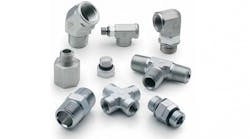We're starting to put the March issue together, and one of our feature articles will address hydraulic fittings. More specifically, the topic is hydraulic flanges. It's written by Tim Abrams, of Anchor Fluid Power, and it delves deeply into the nuances of hydraulic flanges.
Of course, fittings are generally thought of as connections that screw together, whereas flanges are held together by the tension of screws or bolts.
Here's the beginning of his blog entry:
Turn VS Torque: Does it Really Matter Which Technique You Choose?
In front of you is an NPTF tapered thread assembly. The recommendation is to ‘turn,’ not ‘torque,’ to assemble the connection. But all you have is a torque wrench. Or maybe you have an SAE straight thread port assembly, which has a suggested assembly torque, and your torque wrench is nowhere in sight.
Time is wasting. The inevitable question pops up: Can’t you just crank that fitting down and be done with it? Tight is tight, right?
Short Answer: It Does Matter. Here’s why.
In the case of torque, we use a calculation to determine how much torque hydraulic threads can handle without being damaged. Going over or under the recommended torque can lead to leaks. That likely makes sense to you if you’ve gone below recommendations – a loose fitting can lead to leaks – but might make less sense if you’ve gone over.
When you tighten a fitting, in some circumstances you’re actually deforming the metal, which can damage threads and sometimes the fitting, making it unfit for re-use. In other circumstances, an O-ring could be pushed down into the female threads, compromising the seal of the connection. Additionally, if that O-ring is old or dry, it can crack under too much pressure, leaving you without a proper seal and again the possibility of leaks. The same holds true for the methods requiring turning the fitting.
So even if you think you’re a torque wrench or assembly master, when you tighten based merely on your sense of what feels right, you have most likely over-torqued/tightened your fitting.
Click here to read the rest.


